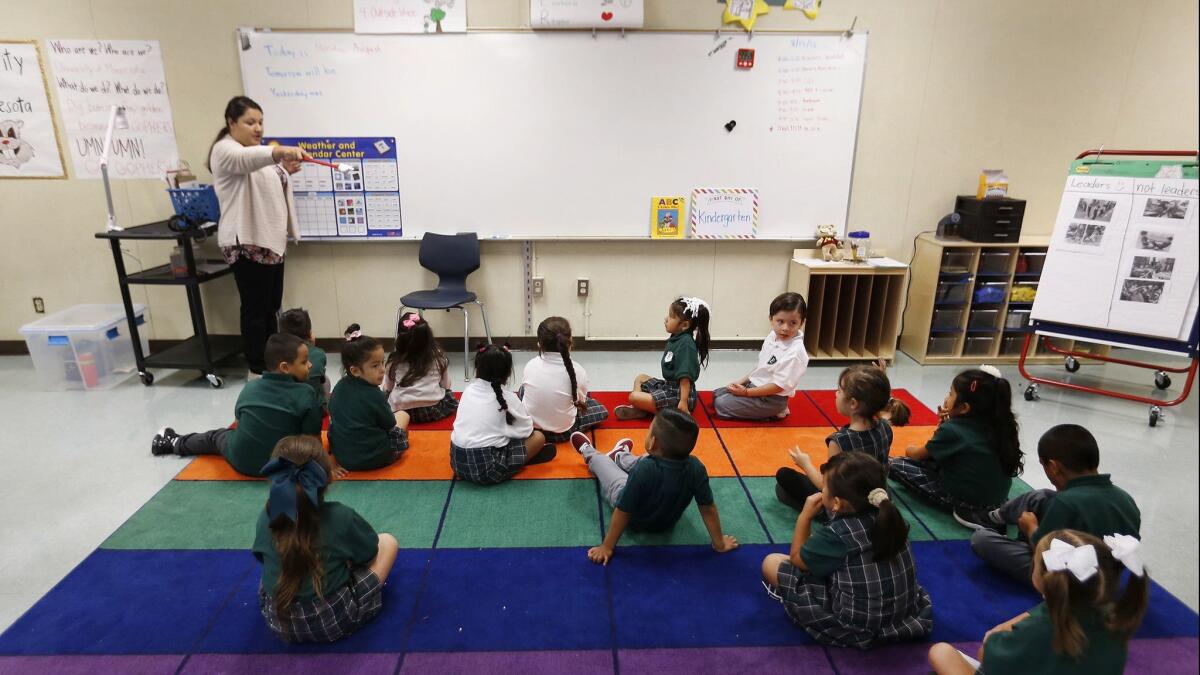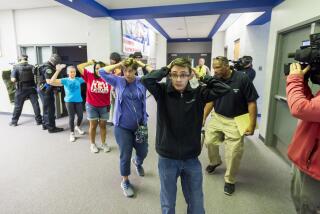Op-Ed: Betsy DeVos was (sort of) right. We should arm teachers — with supplies, support and a livable salary

During her 2017 confirmation hearing, U.S. Secretary of Education Betsy DeVos said teachers may need guns, citing an elementary school that had grizzly bears nearby. The comment, understandably, elicited groans. But perhaps DeVos was on to something. Although there is no rationale for guns in the classroom, in Wyoming or anywhere else, there is indeed something stalking our public schools, and teachers should be armed accordingly.
Let me explain.
I am a new public school teacher. The charter elementary school where I work, while pedagogically inspiring and impressively staffed, is a reflection of our education system as a whole: sedulous people stretched too thin; classrooms with too many bodies; little, if any, funding.
Talented young people have stopped seeing education as a long-term career goal.
My day starts at 6:30 a.m. I prepare for two hours before students arrive, as I won’t have a break all day. I have a 40-minute lunch, but more often than not this small window is spent counseling an emotionally challenged student or hastily putting supplies out for the end of the day. I have no classroom help; I did have an aide for one hour a week, but that position was recently cut altogether. I have 27 students, including seven with either IEPs (Individualized Education Plans for special needs students) or 504s (behavioral plans for other state-identified disabled students). I am expected to adapt lessons to accommodate each of them while also supporting my other 20 students, all of whom have needs of their own. I have 27 papers, 27 quizzes, 27 projects, 27 small group assignments to grade — weekly.
I frequently pay for school supplies out of my own pocket — including pencils — but my salary is nominal. I have an advanced degree and I can barely pay my rent in Los Angeles. I live, truthfully, paycheck to paycheck.
In case you’re wondering: I am a good teacher. Room to grow, yes. Experience to garner, absolutely. But I am dedicated and passionate about childhood education. (On top of teaching, I host a children’s storytelling podcast.) And yet I cannot help but ask myself, daily, how so many people do this job. If someone as committed as I am to children and education is drowning in expectations, crying at night, falling prey to monthly illness due to lack of sleep, who does survive this business?
I recently posted on social media a droll comment about the 27 report cards I was expected to write (one per child, five sections per report, four subsections per section, each requiring written comments to boot), yet with no paid work hours allotted to the task. The amount of affirmative responses I received was staggering. Colleagues and fellow teachers from past lives chimed enthusiastically, “PREACH!” and “I feel your pain, too.” And, my personal favorite, “So sad. So insane. So accurate.” Why has this been allowed to become the norm?
The high-stakes testing. The poor wages. The cramped classrooms. The asks are too large. The needs, insurmountable. Even for young and energized teachers like myself, it is too much. Visit the Instagram account @bored_teachers for an unending, but accurate, supply of grievance content.
This is the bear dangerously circling our schools.
Despite decades of good intentions, policy changes enacted from either end of the political spectrum have failed. Today we have a profound disconnect between the Betsy DeVoses of the world — policymakers, conservative and liberal alike, who have not spent time working in a classroom — and the people who are actually in the trenches.
Exasperated, this year hundreds of thousands of teachers protested, rallied or walked off the job in West Virginia, North Carolina, Kentucky, Colorado, Oklahoma, Arizona and Washington. Unionized teachers in Los Angeles may strike in January. The common refrain: We can’t take it anymore. Some small victories were won — and 177 current teachers were energized to run for state legislatures — but nothing near the level of systemic change that’s needed.
The whole education enterprise seems under threat. Turnover continues to climb as teachers burn out and leave the field. According to a 2016 study, “Compared to high-achieving jurisdictions like Finland, Singapore, and Ontario, Canada — where only about 3% to 4% of teachers leave in a given year — U.S. attrition rates are quite high, hovering near 8% over the last decade, and are much higher for beginners and teachers in high-poverty schools and districts.”
Enter the Fray: First takes on the news of the minute from L.A. Times Opinion »
Talented young people have stopped seeing education as a long-term career goal. Who goes to college looking for a 60-hour-a-week job that might require a second job to keep mouths fed and electricity bills paid? Apparently, very few people at all. At California universities, enrollment in teacher preparation programs is down 20% from five years ago, and 70% from 2002.
Schools are now in a vicious cycle. They cannot maintain enough qualified teachers, so districts hire underprepared candidates and wind up with overcrowded classrooms, which leads to frustration and turnover, which in turn threatens funding, causing schools to flounder, perpetuating low interest in entering teaching, and so on.
This is the menacing and localized peril to schools. In lieu of literal weapons, teachers must be given the time and the tools to defend themselves and their classrooms from these unremitting threats. While students should be at the forefront of our thinking on public education, we simply cannot fix this systemic catastrophe without first arming teachers with what they need. Perhaps, to start, a few damn pencils.
Natalie Babcock is in her second year of teaching elementary school in Los Angeles. She previously worked in early childhood education in the Bay Area. She also hosts Small Tales, a storytelling podcast for children.
Follow the Opinion section on Twitter @latimesopinionand Facebook
More to Read
A cure for the common opinion
Get thought-provoking perspectives with our weekly newsletter.
You may occasionally receive promotional content from the Los Angeles Times.






